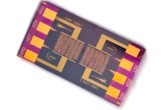RFID replacement for barcodes
Holst Centre, imec and their partners in the EU FP7 project ORICLA have fabricated an RFID (radio frequency identification) circuit made in low-temperature, thin-film technology that allows reader-talks-first communication. The technology behind this prototype is used to create RFID tags that are cheap enough and have enough performance to be used as intelligent item-level tags on the packaging of retail consumer goods. Such tags can be used to provide buyers with information on details such as price, characteristics, freshness or to allow vendors to implement automated billing and inventory management.

Thin-film RFID chips are made on plastic foil, with organic or oxide thin-film semiconductors. Until now, RFID tags with such thin-film chips on plastic were based on a tag-talks-first principle: as soon as the RFID tag gets powered from the RF field of the RFID reader, it transmits its code to the reader. But in retail applications, many tags will try to contact the reader at the same time, requiring an effective anticollision mechanism. Such a scheme has never before been implemented; tag-talks-first RFID anticollision measures have been limited to about a maximum of four tags and come at the cost of a slow reading time.
“With this technology,” says Paul Heremans, imec Director large-area electronics and coordinator of ORICLA, “we are, for the first time, able to realise a reader-talks-first, low-temperature, thin-film transistor (TFT) RFID circuit. When the RFID reader first powers and contacts the tag, it transmits a clock and identification data. The tag then uses this data and clock to determine when to send its code. This mechanism for the first time allows implementing a practical anticollision scheme for thin-film RFID tags.”
For this new RFID tag, a complementary hybrid organic-oxide technology was used, combining a 250°C solution-processed n-type metal-oxide TFT with typical charge carrier mobility of 2 cm2/Vs with a pentacene p-type TFT with mobility of up to 1 cm2/Vs. A high-k Al2O3 dielectric was used, which increases the transistors’ current drive.
Thin-film electronics are circuits that are made up of organic and metal-oxide molecules. They have the potential to be produced very cheaply, with print-like processes on thin plastic sheets. One of the driving forces of this industry is the ambition to create intelligent RFID tags that are at the same time intelligent enough and cheap enough to be printed and used on mass-produced retail products.
The project partners are the project coordinator imec (Belgium), Holst Centre - TNO (The Netherlands), Evonik Industries AG (Germany) and PolyIC (Germany).
Digital labelling trial proposal in NZ for certain imported food
The New Zealand Minister for Food Safety is seeking feedback on a proposal to enable a trial of...
CCEP's reverse vending machine rollout
Coca-Cola Europacific Partners' first RVM has opened in Moorabbin, with others planned across...
Smarter 'natural' packaging for food of the future
From food waste sugars into natural plastic films, researchers at Monash University are creating...








